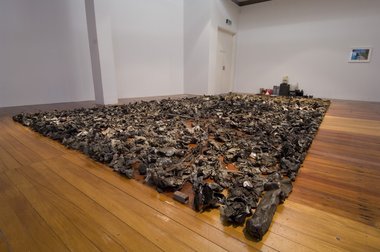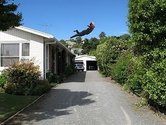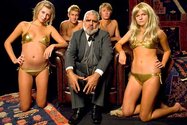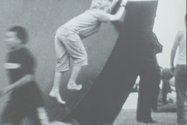John Hurrell – 25 March, 2010
It has a great poetic and metaphorically loaded title, a superb hardcover catalogue with three excellent essays, and a new large downtown venue, but what of the art? Is it memorable?
The 4TH Auckland Triennial
Last Ride in a Hot Air Balloon
Mike Parr, Alicia Frankovich, Robert Hood, Martin Boyce, Laresa Kosloff, Richard Bell
12 March - 20 June 2010
Part One
Bodies at Risk
The 4th Auckland Triennial curated by Natasha Conland has been with us for over a couple of weeks now, so what does one make of it? It has a great poetic and metaphorically loaded title, a superb hardcover catalogue with three excellent essays, and a new large downtown venue, but what of the art? Is it memorable? Does it provide examples that stick in the mind like say - to look at the earlier exhibitions - Ashley Bickerton and Roni Horn did in Bright Paradise, or Ilya and Emilia Kabakov and William Kentridge in Public / Private, or Willie Doherty and Issac Julian in Turbulence?
The show is less overtly finger-waggy than Turbulence, but you still sense Conland is very much a schoolmarm - only more circumspect. She has a lighter touch than Victoria Lynn, allowing more whimsy and humour to mix with her didacticism. (Comparing the two titles shows that.) Yet for my money, that side of her intelligence, her appreciation of wit and irony, came out much more in Mystic Truths, a much smaller, non-Triennial show than say Earth Matters, a Triennial warm-up. Nevertheless Last Ride in a Hot Air Balloon is impressively focused. It doesn’t feel sprawling or scattered in its content. There are about five themes that reveal themselves (often several overlapping) in all of the works, but which may not be at first obvious. They are Bodies at Risk; The Journey; The Imagination; The Economy; and Dialogue.
Therefore I want to take a look at the Triennial in a manner that ignores the placing of the twenty-eight artists within the separate venues and elaborate on these five overarching themes instead. I want to briefly provide some interpretive possibilities, putting five or six artists in each category, and then looking at each in turn.
The first theme is ‘Bodies at Risk‘. Although the theme of risk is discussed constantly throughout the essays and catalogue entries, it is more global economic vulnerability (Conland’s essay), or explorative navigational risk (Doryun Chong’s text), or linked to the artist’s body (Leonhard Emmerling’s discussion) - not that of the viewer. While artists like Mike Parr and Alex Monteith have made films or performances where the viewer empathises with the artist’s or film-maker’s body in pain or in danger, there is no sense of implied audience peril anywhere in this exhibition. None of the sculpture for example is menacing in its ambience in the way that sculpture, like say the kinetic works of Len Lye or Peter Roche, can be.
With Parr’s work at George Fraser the outside windowed gallery is the site of a very early (1970) text work where he describes in a hundred vinyl-cut sentences attached to the wall, the properties of a room, its space and what is seen through the windows. At his artist’s talk this work was linked to a film of his ‘Hundred Breaths‘ (Alphabet - Haemorrhage, 2003) performance of sucking self-portrait prints to his face one by one till on each occasion, his oxygen runs out. The room becomes a trope for his interiority, his ruminating self enclosed within his body as he looks out its windows. This in turn is paralleled in one of the films he shows in the darkened inner gallery, where he is rolling a recording movie camera up and over a hill. The camera lens swishing through blurs of long grass could be Parr’s decapitated head.
Alicia Frankovich’s AAG installation shows a hospital ‘drip’ made out of two end-to-end Martini bottles pouring orange liquid into a small swimming pool, to be then repumped up and recycled. The fluid could be a cocktail of blood, urine, sweat and tears, and seems to be alluding to artists recycling earlier art. In a corner is a Duchampian rack holding orange shopping bags from the Pergomon Museum in Berlin, on one wall is a neon that seems to allude to very early Richard Serra, and a ball suspended in a ‘testicular’ harness refers to her own history and mindset. With the rack of shopping bags entitled Woman, and a pinned up skirt displayed with a found drawing of graphite traces, Frankovich has with her installation and bodily absence created one of the more witty and visually compelling works in the Triennial.
Inanimate objects representing the human body are explored further with Robert Hood driving his Cortina from Christchurch up to Auckland earlier this year where it was taken to a shredder and ‘atomised’. The remnants are laid out on the gallery floor like a large bed. A real time audio recording of the trip is provided alongside Hood’s appropriated (and inserted) self-portrait version of Yves Klein’s famous ‘leap into the void’ photograph. In such a grouping, driver and vehicle symbolically merge.
With Martin Boyce we have the large gallery at St. Paul St blindingly illuminated by a weblike structure of white fluorescent tubes suspended from the ceiling. A black construction of broken wooden chair parts hangs like a Calder mobile, but seems to also reference (perhaps be a substitute for) Bruce Nauman’s turning wax dog corpses and decapitated white male heads. On a remote wall is a black, wire-mesh cubist/tribal mask watching in silence.
Aboriginal activist Richard Bell may smile sweetly during his videoed games of free association, but his critique of white Australia, with its youthful blonde representatives attired in gold laméd bikinied splendour, is excoriating. He is of course, deeply body conscious - as they are too of him, though he is fully dressed. With his dangerous charm he coaxes out a series of racist jokes for our delectation. If in the normally dismal Shed 6 we stay and listen, we become complicit - especially if we laugh: as Bell himself does. If we walk away, we (physically, hopefully not mentally) desert the artwork.
Fellow Australian Laresa Kosloff films bodies in action, airborne as a clowning trapeze act, or climbing over public sculptures in a park as bored children, or groups of adults exercising. Like Mike Parr’s rolling camera, Kosloff also films as if the camera were a moving figure - in her case while ascending and descending in a lift, looking out through a tall building’s windows. Her subject matter is contemporary for the looping footage we see at ARTSPACE is recent, yet the super 8 black and white film makes it look much older. You wonder if these people are still alive now, but of course probably they are, very much so.
It is difficult, naturally, to separate the human body from the activity of travel. ‘The Journey‘ - and the Triennial’s title - will be the subject of Part Two.
Jennifer French’s documentary photographs and DVD stills are of works by Robert Hood, Martin Boyce, Richard Bell and Laresa Kosloff.






 Advertising in this column
Advertising in this column Two Rooms presents a program of residencies and projects
Two Rooms presents a program of residencies and projects



This Discussion has 0 comments.
Comment
Participate
Register to Participate.
Sign in
Sign in to an existing account.